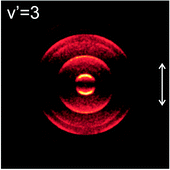Ion imaging methods have enabled identification of three mechanisms by which 79Br+ and 35Cl+ fragment ions are formed following one-color multiphoton excitation of BrCl molecules in the wavelength range 324.6 > λ > 311.7 nm. Two-photon excitation within this range populates selected vibrational levels (v′
= 0–5) of the [X 2Π1/2]5sσ Rydberg state. Absorption of a third photon results in branching between (i) photoionization (i.e. removal of the Rydberg electron—a traditional 2 + 1 REMPI process) and (ii)
π*
←
π excitation within the core, resulting in formation of one or more super-excited states with Ω
= 1 and configuration [A 2Π1/2]5sσ. The fate of the latter states involves a further branching. They can autoionize (yielding BrCl+(X 2Π) ions in a wider range of v+ states than formed by direct 2 + 1 REMPI). Further, one-photon absorption by the parent ions resulting from direct ionization or autoionization leads to formation of Br+ and (energy permitting) Cl+ fragment ions. Alternatively, the super-excited molecules can fragment to neutral atoms, one of which is in a Rydberg state. Complementary ab initio calculations lead to the conclusion that the observed [Cl**[3PJ]4s + Br/Br*] products result from direct dissociation of the photo-prepared super-excited states, whereas [Br**[3PJ]5p + Cl/Cl*] product formation involves interaction between the [A 2Π1/2]5sσ and [X 2Π1/2]5pσ Rydberg potentials at extended Br–Cl bond lengths. Absorption of one further photon by the resulting Br** and Cl** Rydberg atoms leads to their ionization, and thus their appearance in the Br+ and Cl+ fragment ion images.

You have access to this article
 Please wait while we load your content...
Something went wrong. Try again?
Please wait while we load your content...
Something went wrong. Try again?


 Please wait while we load your content...
Please wait while we load your content...